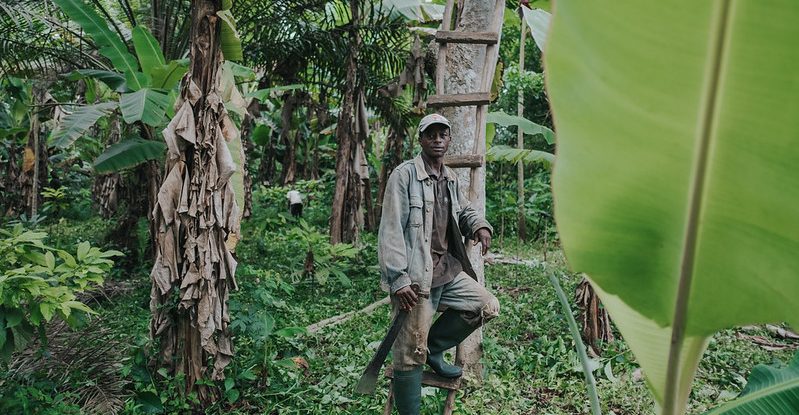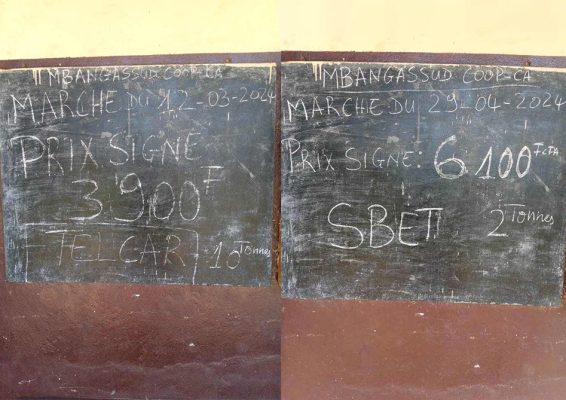
Have you noticed how chocolate is getting more expensive?
If you haven’t yet, you likely will soon: cocoa prices have been soaring since late 2023, reaching a record high of USD 10.97 per kilogram in April this year. It’s happening because the combination of climate change impacts and the El Niño weather pattern have hammered harvests in cocoa-growing countries – the four main ones in Africa being Cote d’Ivoire, Ghana, Nigeria, and Cameroon.
While low harvests are disappointing for producers, there’s a small silver lining in that scarcity of supply pushes price-per-unit up. In 2022-2023, the maximum price paid to producers was USD 2.44 per kilogram, whilst in March 2024 that shot up to USD 8.40.
Yet the rate rise is far from uniform, with Cameroonian, Nigerian and Democratic Republic of Congo (DRC) cocoa farmers receiving around triple the prices of those in Cote d’Ivoire and Ghana in early 2024.
To understand this discrepancy, we need to go back in time.
Old policies, new impacts
The variability in the rates producers in these countries are receiving today can be seen as a result of recommendations made by the Bretton Woods Institutions (the World Bank and the International Monetary Fund (IMF)) three decades ago. These institutions promoted liberalization of the export crops sector, and advised removing stabilization institutions that regulated the value chain of crops such as cocoa and coffee to ensure that farmer prices better reflect international market prices.
Not all countries responded in the same way. Cameroon quickly liberalized its cocoa sector in line with the suggestions given. As its farmers grappled with the volatility of international cocoa prices, they became more interested in working out which other crops they could usefully and profitably grow alongside and in amongst cocoa. They became experts at growing cocoa under the shade of other trees, with positive ecological and economic results. Essentially, the farmers’ vulnerability pushed them into greater reliance on associated exotic fruit trees and indigenous non-timber forest products, which also yielded considerable environmental benefits.
That agri-biodiversity continues to this day.
In southern Cameroon, for instance, a cocoa farm contains an average of 21 associated species with a range of edible, medicinal and timber-producing functions. These associated species together account for 70% of the total carbon stock within cocoa farms. And such stock is considerable: a diverse and complex cocoa agroforest contains approximately 60% of the carbon stock found in local primary forests.
Similarly, in the Bengamisa-Yangambi landscapes in the heart of the Congo Basin in central DRC, researchers found an average of 13 species on each cocoa farm. Because farmers did not plant the same species as each other, when data from 25 cocoa farmers was combined a total of 89 species were identified at the landscape level. This highlights the positive impact of each farmer’s unique interest in diversity on their individual plots.
Additionally to biodiversity, in the Yangambi Biosphere Reserve (DRC), a cocoa farm stores around 50% of the above-ground carbon found in mature forests, which is not the case with others land uses such as food crops. So, maintaining these associated plants helps to perpetuate a structure that mimics that of the local forest and provides farmers with some of its services. By diversifying livelihood sources, this system reduces dependency on cocoa price fluctuations and ensures food security and nutrition while conserving, protecting, and enhancing natural resources and resilience to climate change.

Cote D’Ivoire and Ghana, meanwhile, implemented measures to maintain price stabilization, and farmers did not experience this pressure to change their practices. There, monocultural cocoa plantations proliferated – often in the place of forests. To this day, cocoa farms in West Africa have fewer species than those in Central Africa. Now, as climate impacts strike, efforts are being made to promote agroforestry, diversify incomes and build resilience in these countries’ cocoa sectors, but there remains a long way to go.
Meanwhile, farmers in both countries are unhappy that they’ve struggled with low yields just like their counterparts, but haven’t benefited nearly as much from price rises due to their governments’ ongoing price-setting systems: in Cote D’Ivoire, farmers threatened to strike, resulting in a 50% increase in the farm gate price in April, and Ghana followed suit soon thereafter.
Where to from here for Africa’s cocoa producers?
Across the region, how might these latest price fluctuations impact on cocoa-growing people, economies and landscapes? Macroeconomically, price increases tend to have a positive effect on countries’ balance of payments, employment, and economic growth, while at the microeconomic level, the increase in cocoa price will contribute to solving some key challenges faced by supply chain actors, especially farmers – including access to a decent living income, proximate microfinance, good-quality and timely inputs, labour, healthcare, and basic services like education and shelter.
Environmentally-speaking, however, cocoa development without proper safeguard measures can indirectly lead to deforestation. Evidence from a survey of 1035 smallholders in cocoa production basins in Cameroon and Gabon shows that marginally-higher income from cocoa is associated with six to seven times higher deforestation than other livelihood strategies, with a significant spatial spillover effect on neighbouring households’ deforestation.
In the context of emerging international trade regulations on deforestation-free commodities, the question of a development model that improves living standards and the resilience of households – while preserving forests – remains urgent. As price inflation drives increased interest in cocoa perennial crops, there is a growing opportunity to utilize cocoa as a primary value chain to help lift people out of poverty while also considering ecological factors such as preserving remaining forests and engaging in reforestation/afforestation efforts.
To achieve this, the following steps are necessary:
- Ensure that silvicultural research on forest species is adequately funded in national and international research organizations. This should extend beyond logging practices and consider the diverse uses of forest products and services, as well as their potential integration into cocoa farms.
- CGIAR must prioritize forest and agroforestry research as it moves forward with the OneCGIAR approach, which emphasizes the food system. Cocoa orchards, agroforests, and forests (wild and/or plantations) are all part of rural food systems, and for such systems to be sustainable, they must be able to operate in harmony with natural ecosystems.
- Development banks and donors should prioritize financing for forest and agroforestry initiatives in cocoa-producing countries. The sustainability of the cocoa value chain is closely linked to the sustainability of forest species, and support in this area should surpass previous efforts made by the Forest Investment Program (FIP).
- To enhance a sustainable supply chain for cocoa production, the cocoa private sector should accelare its collaboration with the government, NGOs, and research organizations. In addition to market economics practices and current price inflation, they should promote fair and transparent pricing practices. They should also encourage sustainable farming practices that protect the environment and ensure long-term sustainability for cocoa, nature, and producers. Increasing investment in local communities for economic development, education, healthcare, and infrastructure will lead to thriving cocoa villages. The cocoa private sector should also encourage the intermediaries (“coxeurs”) that they buy from to register in the profession, and display the prices they operate, to improve transparency, physical and financial flows and traceability, and thus enable higher prices, higher share of values, and higher living incomes for cocoa farmers
- Environmental safeguards must be established/strengthened in cocoa-producing countries to prevent price inflation from undermining recent efforts to separate cocoa production from deforestation.
It is our hope that West and Central Africa’s cocoa producing countries can put into practice key learnings from past and present experiences from previous cocoa projects/initiatives (including those co-developed with the industry), and develop systems that can sustain their people and ecosystems – and the global population’s appetite for chocolate – far into the future.
Denis Jean Sonwa was a Senior Scientist with CIFOR-ICRAF in Yaounde, Cameroon when he and his co-author began writing this blog, has recently transitioned to a new role as the Director of RDI (Research Data and Impact) at World Resources Institute (WRI) Africa, based in Kinshasa, DRC.
Jonas Ngouhouo-Poufoun was a visiting scientist at the International Institute of Tropical Agriculture-Congo Basin Institute working on the UNEP-WCMC GCRF Trade Hub Project, and is now a senior research fellow in natural resource economics at the University College of London.
We want you to share Forests News content, which is licensed under Creative Commons Attribution-NonCommercial-ShareAlike 4.0 International (CC BY-NC-SA 4.0). This means you are free to redistribute our material for non-commercial purposes. All we ask is that you give Forests News appropriate credit and link to the original Forests News content, indicate if changes were made, and distribute your contributions under the same Creative Commons license. You must notify Forests News if you repost, reprint or reuse our materials by contacting forestsnews@cifor-icraf.org.
Further reading
- Trajectories of Cocoa Production in Tshopo Province: Potential for Climate-Change Mitigation
- Preliminary estimation of above-ground carbon storage in cocoa agroforests of Bengamisa-Yangambi forest landscape (Democratic Republic of Congo) - CIFOR-ICRAF Knowledge
- Impacts du changement d’utilisation des terres sur la biomasse et la diversité dans le paysage forestier de la réserve de biosphère de Yangambi en République démocratique du Congo - CIFOR-ICRAF Knowledge
- Profiling Carbon Storage/Stocks of Cocoa Agroforests in the Forest Landscape of Southern Cameroon
- Cocoa, livelihoods, and deforestation within the Tridom landscape in the Congo Basin: A spatial analysis
